This 64km loop runs north from Swaffham joining the same Roman road as the Downham Market loop but heading in the opposite direction over the hill for amazing panoramic views of the medieval planned village of Castle Acre. The route then follows the beautiful shallow Nar valley past prehistoric sites, ancient churches, medieval manors and through timeless villages. Curve south into the fascinating village of Gressenhall and then weave round grass centred lanes into Dereham, the largest town in north Norfolk and a lively change of pace from the tranquil lanes you’ve been drifting along. There’s no shortage of history to take in here, from Bronze Age axes to Zeppelin raids and at just over halfway it’s a great place to refuel and rest awhile.
From Dereham you glide west past more moats and medieval halls along deserted roads and unspoilt flint and brick-built villages. There’s also a recommended detour to visit the incredible 11th century wall paintings in the restored church that’s the only remaining part of Houghton village. Then it’s time to wind up the gentle gradient past the old nuclear weapon armed airfield at Pickenham before rolling down into Swaffham and up to the market square to finish.
The route is mainly on road but does include some farm tracks and grassy singletrack trails. It’s still suitable for a touring or road bike but there may just be a few hundred yards of walking involved.
Market square to medieval gem
This route uses the same start as the Sandringham loop, but where the Sandringham loop turns left into woodland on the Roman road alignment, the Dereham route turns right onto broad farm track. Persevering sees you roll over the crown of the low hill to a stunning panorama centred on Castle Acre with its massive ramparts at one end and vast ruined priory at the other.
Rolling down the track, a back lane brings you to a broad ford over the River Nar (don’t worry there’s a footbridge too) where you get a closer view of the Cluniac priory, but you can always loop round to the gatehouse if you want a proper visit. You’ll be rolling through a portcullised medieval gate into the village and although it’s early in the route it’s well worth stopping to explore. The huge banks and moats of the castle are a must-see monument to the Norman Warenne family who took the site off the Anglo-Saxon noble Toki.
Further back in time
Rolling out of the castle car park there’s a slightly dirty but fun diversion across Broadmeadow Common before you arrive at a beautiful long mill and bridge astride the river. If you go past the official bridleway routing and signposts, you’ll find a temporary diversion back onto the same track. There’s also an entirely road equivalent of this section if you don’t want to get your tyres dirty, but means you miss the picturesque lane past the ornate gardens, glamping site and fishponds of West Lexham Hall, the formidable flint walled barns of Street Farm and the tiny hamlet of East Lexham with its old wooden shelter and charming cottages. Climbing up across the river you get a glimpse of the round tower of St Andrews church which is the oldest in the country.
Several prehistoric tumuli burials and a Romano British settlement line the way to the conservation village of Litcham where you’ll find the 14th century Bulls Inn from when it was on the Kings Lynn to Gt Yarmouth stagecoach route. Ornate painted sculptures inside All Saints church show it was on the holy map from at least the 12th century. You soon rejoin the east - west Roman road alignment towards the deserted village of Little Bittering. Here keen eyes will pick out the lumpen remains of old houses and the moated manor either side of the road but you’ll have to detour off into a small copse if you want to follow the ‘Launditch’ to the ‘Hell Pit’.
Dereham
The extended villages of Gressenhall and Beetley are definitely worth an explore too, with a large workhouse museum that has regular activity days, a well-preserved watermill and several walks around the head of the Wensum river. Quiet lanes twist and turn south to Dereham where you can join a short cycle path that rolls you right into the historic and religious centre of the ‘Heart of Norfolk’. The largest town in the area has an archaeological footprint that starts with rare Neolithic green stone axes, includes Bronze and Iron Age finds as well as a hoard of over 1000 Roman coins. It’s the story of St Withburga's Well that made it a place of pilgrimage through the Middle Ages when it also gained a twice weekly market. The once closed Wymondham and Worthing track has been revived as a tourist line by the Mid-Norfolk Railway Preservation Trust. At just over halfway round the loop it’s an ideal spot to have a rest and a bite to eat before heading back, or to use as a staging post onwards to Norwich and the other Cycling UK Experience hub at Wroxham.
Remote return
From the busy town centre you follow the one-way road south then join National Cycle Network 13 through the suburbs and then out into the fens. Here deserted roads link ancient farms to the splendidly named Daffy Green and double moated manor of Huntingfield Hall. There’s even some slight rise and fall over High Green to wake your legs up and then a mystery Iron Age / Roman /Saxon site with timber ritual shafts to prick up your historical thirst before you get to the pub near the village green in Ashill. There’s also a recommended detour to visit the incredible 11th century wall paintings in the restored church that’s the only remaining part of Houghton village. Then it’s time to wind up the gentle gradient past the WWII built, Cold War nuclear weapon armed airfield and now turkey farm at Pickenham before rolling down into Swaffham and up to the market square to finish.
Disclaimer
All routes are followed at a rider’s own risk. These routes are intended to be general guides: please observe all road signs, waymarks and other specific on-route instructions. Neither Cycling UK nor individual route authors can be held responsible for any errors or consequences that arise from using this route information. Essentially: go out, be sensible, have fun. If you believe there is an important issue with this route then please report it using the button below.

Supported by

